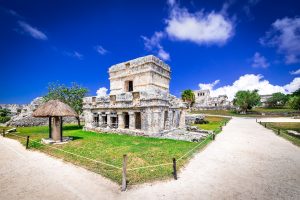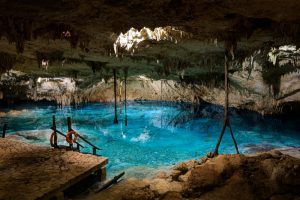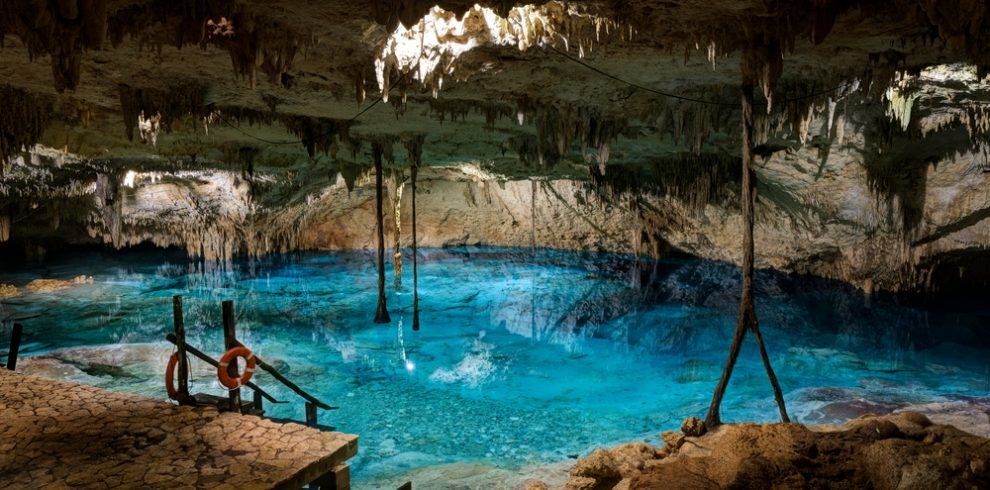Overview

Tulum
Brief History and Description
Tulum emerged in the late Postclassic period, around 1200 A. C. E according to archeaological and artistic-historical investigations.
Consider the importance of Tulum’s mural paintings.
Although the murals found in Tulum at structure 16 better known as the temple of the Frescoes are not well conserved, evidence has been found about similar patterns between these paintings and the Mixtec codexes (prior to the conquest) as well as the ones in Mitla, Oaxaca, Mexico (belonging to a Poblano-Mixtec tradition)
This is a lead that Tulum was a prosper site in the late Postclassic because these paintings seem to have been the work of foreign artists hired by local elite members.
Such works of art indicate that Yucatan eastern coast governors of this Maya history stage were part of a very widepread net – even through marriage and commercial alliances – that related the elites of many different ethnic groups throughout Mesoamerica.
Perhaps Tulum was founded to set up a trading center on the Yucatan east coast, maybe by a Putun Maya group allied with Mayapan governors.
It is believed that Tulum was controlled by Mayapan which after 1200 A. C. E dominated the Yucatan peninsula keeping a strong union among the different Maya sites in the area for around 250 years. Mayapan was destroyed in 1441 according to four native chronicles and two Spanish authorities, however, the port of Tulum was still occupied during the Spanish conquest.
Architecture in Tulum
An average 6-meter thick and 3-5-meter high masonry wall surrounds Tulum north, west and southwards whereas its east protection is made up by sea cliffs averaging 12 meters in height.
The site’s architecture is mainly based on a non-refined masonry which can be seen in platforms and its varied buildings featuring at once beam-and-mortar roofs (structures 1, 21, 25) and colonnades (circular and square ones). Some of these buildings facades were decorated with stucco reliefs such as the Castillo (structure 1) and the temple of the Frescoes (structure 16). Tulum’s masonry’s roughness is evident and it was covered with a thick plaster, contrary for example to other Maya sites such as Uxmal (West Yucatan) where specialized stones on lower walls (the governor’s palace) were well squared, placed and arranged in such a way so as to get a uniform joint between them, made up by a few milimeters, involving a high precision stonecutting work where all these veneer pieces were set into a concrete core.
CENOTE TAAK BI HA (Hidden water) (Description)

Enjoy this incredible underground ecosystem which is an amazing underground lake with see-through water that doesn’t look like, but that it’s a revitalizing place you won’t want to leave. This cenote is also a limestone-karst grotto which rock formations grow about an inch each year, such a phenomenon is caused by rainfall.
The place is naturally beautified with stalactites and stalagmites being the product of rain drops sapping and dissolving carbon dioxide taken from the atmosphere through limestone layers depositing various minerals along the cenote’s ceiling.
As you must know, the Yucatan peninsula was at some point during the earth’s history covered by ice, which eventually got melted yielding right of way to water drops that gradually eroded the limestone surface giving along the years place to caverns and a net of underground rivers.
But the question is: Which way would you prefer entering here? Held by a rope all the way down or through the stairways? Sleep on it and make up your mind, whatever your decision is will be good!
All the information regarding Tulum, its buildings and its places, as well as everything related to cenote Taak Bi Haa, will be thoroughly explained by your Tour Guide who is certified by SECTUR (Mexican Tourism Department).
If you’re interested on a significant discount, please, contact us through WhatsApp, it is the only way to get it.

